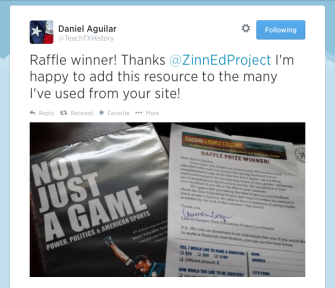 This spring a volunteer research team conducted a survey of the Zinn Education Project network.
This spring a volunteer research team conducted a survey of the Zinn Education Project network.
We offer our appreciation to the more than 800 people who took the time to give us their thoughtful feedback about what it means to teach people’s history and the role of the Zinn Education Project. As promised, 20 names were selected at random from the survey respondents to receive a copy of the DVD Not Just A Game.
Our next step is to conduct interviews with selected survey respondents this summer. While we plan to have a full summary available later this year, here are a few comments from survey participants.
What is most useful to you about the website?
Lesson ideas and resources which allow me to meet the needs of diverse learners.
Exciting discussion of real education/pedagogy, working with thinking and activist colleagues—things education “reform” keeps trying to take away from us.
That’s what I love about ZEP—so many of these resources I have never heard about.
I find comfort in knowing that there are other progressive educators, committed to teaching social justice through the website or others. It is often lonely—rewarding, but lonely—doing the work of teaching for change.
It has become a primer for further research and study.
Membership in a community of educators working for social justice.
Love the variety of presentation styles of resources and information.
The most useful part of the website are the articles written by educators using the lessons in the classroom. Hearing how effective they are for the children across the country gives me hope that I can utilize these lessons across the age groups represented in my congregation.
The various lessons available on the page serve as good inspiration for the development of my own materials.
Why do you use Zinn Education Project lessons/activities?
These activities take what state standards make shallow and meaningless, and create ways of presenting the material that allows students to interpret history on their own in order to critique our society past and present in a meaningful way.
I use Zinn materials to remind myself of my commitment to teaching for social justice and the wider community that exists beyond my school that is likewise committed.
The point of view is inclusive and just, as well as accurate and complete. I love that the content does not avoid complexity and conflict. These are outstanding contributions to the lives of teachers and students.
I find ZEP to offer a renewal of the belief that theorizing can occur in the margins. As a Latino professor in a Hispanic serving institution, it’s important that my students experience schooling that is empowering and liberating, skewing away from hegemonic “do as the book says” teaching.
Many of them are fun and engaging, and they deal with controversial and emotional topics that students instinctively get behind.
My students (low-income, single parents, exploring college) are living the issues in unique ways as they explore the role of higher education in creating more opportunities and “second chances” for themselves and their children. I think these resources feel real and hopeful in unique ways. They also help bring some shape to the women’s desire to be of help and service to others as one of their drivers for education.
My students are Alaskan Natives, and so are used to being on the margins of history. They become more interested when other groups that share similar struggles are brought to the forefront in lessons.
The site provides a good example of how curriculum can be rich and meaningful rather than dry and cursory.
They encompass social justice issues and alternative points of view from any textbook. They address the “other people” which are my students, minority students.
They’re well-designed: participatory, Freirian, thought provoking, and focused on subjects that stir controversy, and therefore interest, among students.
The survey was designed and conducted by University of Maryland assistant professor Katy Swalwell with support from University of Maryland doctoral student Kristin Sinclair and George Washington University students Camille Henley and Juan Rodriguez.







Twitter
Google plus
LinkedIn